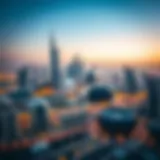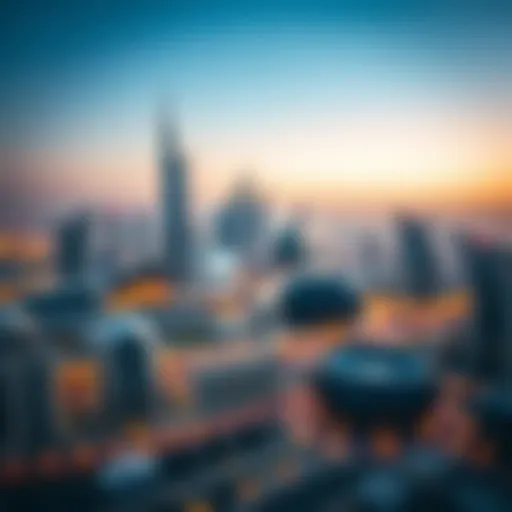Burj Khalifa: Architectural Significance and Structure
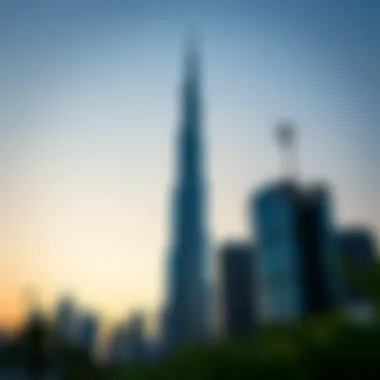

Intro
The Burj Khalifa, piercing the clouds with its astonishing height, is not just a skyscraper; it's a symbol of ambition and innovation. Standing in the heart of Dubai, this architectural wonder pushes boundaries and ignites dreams. But what's behind this remarkable structure? What drives its significance beyond the skyline? To appreciate the Burj Khalifa fully, we must peel back the layers of its design and construction, exploring how it emerged as a defining mark on the world stage. Its sheer size, intricate details, and cultural impact are the beating heart of this exploration.
There’s a lot to unpack when it comes to both the physical edifice and its role in real estate dynamics. From the staggering number of floors, each crafted with care and ingenuity, to how this monument reflects and influences the market, every angle reveals insights worth noting. Let’s begin by examining the prevailing trends in Dubai's property market, looking specifically at what makes locations near this awe-inspiring tower particularly attractive to investors and residents alike.
Preface to Burj Khalifa
The Burj Khalifa stands as a towering testament to human ambition and engineering prowess. It is not just a structure; it embodies the spirit of innovation. In this article, we dive into the intricacies of one of the most iconic skyscrapers across the globe, emphasizing how its significance reaches beyond mere aesthetics.
For investors, realtors, renters, developers, and homeowners, understanding the Burj Khalifa's structure can offer insights into the broader trends of urban development and investment opportunities in Dubai. The skyline of this vibrant city is not just a backdrop; it represents economic ambition and cultural identity. Exploring the Burj Khalifa provides a unique look at how architecture and vision come together to create lasting legacies.
It is crucial to note that while the height and grandeur of the Burj Khalifa capture attention, the underlying purpose and vision behind its construction are equally compelling. The skyscraper serves various roles—be it as a business hub, a tourist destination, or a residence, all multiplying its significance.
A Brief Overview of the Structure
The Burj Khalifa is not only the tallest building globally, but also a masterpiece of modern design. Rising to a staggering height of 828 meters, the complex boasts 163 floors, providing a rich tapestry of spaces designed for various purposes. This skyscraper's structure employs a unique triple-lobed footprint, which is inspired by the desert flower Hymenocallis. This design is not merely for aesthetic pleasure; it plays a pivotal role in enhancing the building's stability and reducing wind loads on its structure.
From the foundation to the tip, the Burj Khalifa employs cutting-edge materials and engineering techniques that push the boundaries of what is possible in modern architecture. For example, the building's reinforced concrete core and the use of a high-strength concrete mix ensure it can withstand the challenges posed by the harsh desert environment.
Purpose and Vision Behind Its Construction
The initial vision for the Burj Khalifa was to create a global icon for Dubai, attracting tourism and investors while showcasing the city’s aspirations on a world stage. The project began as part of the larger Downtown Dubai development, aiming to redefine urban living in the region.
A crucial aspect of the Burj Khalifa is its role as a mixed-use development. It houses offices, luxury condominiums, a hotel, and observation decks, presenting a microcosm of modern urban life. This wasn’t just about creating the tallest building but rather a vertically integrated community where people could live, work, and visit all within the same space.
Incorporating cultural motifs, sustainable practices, and technological innovations, the Burj Khalifa symbolizes Dubai's rapid growth and economic resilience. Consequently, the construction of the Burj Khalifa became a rallying point for individuals in the construction industry, urban planners, and architects focusing on projects emphasizing sustainability and innovation. This visionary undertaking has not only redefined the skyline but has also positioned Dubai as a beacon of modern architecture worldwide.
Architectural Design and Features
The architectural design and features of the Burj Khalifa are not just about aesthetics; they play a crucial role in its functionality and cultural significance. This section sheds light on how the unique architectural choices have shaped both the experience of the structure and its impact on Dubai's skyline.
Architectural Inspiration and Planning
The design of the Burj Khalifa is a blend of influences that pull together various architectural styles, each contributing something unique to the building's identity. Inspired by traditional Islamic architecture, the tower's tiered spire reflects the region's heritage, while simultaneously drawing from modernist principles. This combination is evident in the building's distinct Y-shaped footprint, which enhances stability and improves the views from all angles. The design was the brainchild of the renowned architectural firm Skidmore, Owings & Merrill, with Adrian Smith as the lead architect. Their vision was to create not just a tall building but a landmark that represents Dubai’s rapid urban growth.
"Burj Khalifa stands as a beacon of existence, echoing the aspirations of a nation in pursuit of the extraordinary."
The planning stages included extensive consultations with engineers, environmental designers, and city planners to ensure the building would not only withstand natural elements but thrive within the socio-economic fabric of Dubai. Every facet of design, from the sweeping curves of the exterior to the innovation in energy efficiency, was meticulously orchestrated, showcasing a harmony between artistic vision and practical execution.
Height and Floor Count
The Burj Khalifa stretches an awe-inspiring 828 meters into the sky, making it the tallest building in the world. This remarkable height is a product of not just ambition but also engineering prowess. The skyscraper consists of 163 floors above ground and two additional levels in the basement. Each floor serves a distinct purpose, from corporate offices in the lower floors to luxurious residences and hotels in the upper echelons.
The number of floors is significant; it tailors the building’s function while maximizing its footprint in the bustling city. This vertical city allows for more green space at the ground level, fostering a more pedestrian-friendly environment. The sheer volume of stories not only alters the skyline but also indicates a burgeoning economy, where a blend of luxury and commerce peaks at impressive heights.
Distinctive Aesthetic Elements
The visual appeal of Burj Khalifa extends beyond its height; it showcases a unique facade that dazzles the eye. Made from reflective glazing, the exterior is designed to glitter under the sun, creating a play of light that changes throughout the day. The pattern of the cladding resembles the petals of a desert flower, evoking the natural beauty of the UAE’s landscape.
Moreover, the building features carefully considered setbacks, fostering a shape reminiscent of a stalagmite rising from the desert floor. These setbacks aren’t merely decorative; they serve to mitigate wind loads, adding to the structure’s stability.


Thoughtfully integrated lighting further enhances its appearance at night, with a subtle yet striking illumination illuminating the tower, turning it into a glowing beacon against the night sky. Such elements not only embellish the building but also reinforce its message as a symbol of advancement and creativity in architecture.
In summary, the architectural design and features of Burj Khalifa encapsulate a blend of tradition and innovation. They are a testament to human ambition and serve an integral function in the broader narrative of Dubai’s extraordinary transformation into a global hub. As each layer of design unfolds, it reveals how deeply intertwined architecture can be with a city's identity and aspirations.
For further reading on architectural marvels, you may visit Wikipedia or Britannica.
This exploration of Burj Khalifa emphasizes the attention to detail and profound thinking that can transform a mere structure into an icon of culture and resilience.
Engineering Feats Behind Burj Khalifa
Understanding the engineering feats behind Burj Khalifa is crucial in grasping not just how the structure towers above the Dubai skyline, but also its significance within modern architectural achievements. This section delves into the elements that make this skyscraper a landmark in engineering, offering insights for investors, developers, and anyone interested in the intricacies of high-rise constructions.
Foundation and Structural Integrity
The foundation of Burj Khalifa is nothing short of groundbreaking. To support such colossal height — 828 meters — engineers designed a massive reinforced concrete mat, a crucial aspect that ensures the stability of the building. This mat measures around 3.7 meters thick and rests upon more than 192 bored piles that are as deep as 50 meters. In simpler terms, it’s like a solid anchor that keeps the tower from swaying like a leaf in the wind.
Moreover, the Burj Khalifa's structural integrity relies on the use of a buttressed core system, which enhances axial load resistance. It’s a clever way to reduce the wind forces that act on the building, providing both strength and stability. As it sways minimally even in harsh weather, the structure showcases advanced engineering techniques like those that ensure safety without sacrificing elegance. Each architectural choice was meticulously calculated to push the limits of what was previously thought possible.
Innovative Construction Techniques
Building the Burj Khalifa was a real tour de force of construction techniques. A key component was the use of a climbing formwork system, which allowed builders to raise the structure quickly and efficiently. Picture a platform that rises with the building, ensuring construction can continue even as the tower climbs higher. This method not only expedited the construction process but also minimized labor costs and improved safety.
Additionally, constructing such a high-rise posed numerous challenges, especially with concrete delivery. To combat potential delays and ensure quality, a high-capacity concrete pump was used, which enabled workers to pour concrete from the ground level to dizzying heights without a hitch. This forward-thinking approach dispels traditional limitations in high-rise construction, setting new standards for future projects.
Materials Used in Construction
When it comes to materials, Burj Khalifa showcases top-notch choices that contribute to not only the aesthetic brilliance but also the durability of the skyscraper. The main structure comprises high-quality reinforced concrete, which provides robust structural support. For the exterior cladding, an intricately designed glass curtain wall system was employed, offering a sleek, modern look while efficiently managing heat and sunlight.
Interestingly, the 103,000 square meters of glass used in the façade helps reflect the sunlight, making the building shimmer and stand out in the desert landscape. Additionally, around 15,500 glass panels were manufactured to withstand the extreme temperatures and conditions faced in Dubai. This thoughtful selection of materials highlights a balance between functionality and style, catering to both investors aiming for longevity and tourists seeking beauty.
"The Burj Khalifa is not just a tall building; it's an embodiment of human ambition, ingenuity, and a testament to what modern engineering can achieve."
Investors and developers can glean much from these engineering feats. The Burj Khalifa isn't merely a status symbol; its success underscores the importance of innovative techniques, strategic material selections, and meticulous planning in the competitive real estate landscape. By understanding the engineering principles behind this skyscraper, those in the field can better appreciate and implement similar strategies in their projects.
Significance of the Number of Floors
The number of floors in the Burj Khalifa is not just a mere statistic; it serves as a metaphorical and literal foundation for understanding its significance. Standing proud at 828 meters with 163 floors, Burj Khalifa pushes the envelope of engineering and architecture. Each floor signifies more than just space; it embodies aspirations, innovations, and the evolving narrative of urban landscapes globally.
Cultural and Economic Implications
From its inception, the Burj Khalifa has become an emblem of Dubai's rapid growth and global ambitions. The sheer height of the tower has transformed not only the skyline but also the cultural fabric of the region. It acts as a magnet for tourists, drawing millions who wish to experience its grandeur firsthand. The economic implications are substantial as well; the building houses corporate offices, luxury residences, hotels, and dining establishments. This mixed-use approach stimulates local and international investment, creating jobs and boosting the overall economy.
Additionally, the tower encourages a sense of national pride among Emiratis, symbolizing their place on the world stage. A unique interplay of cultural identity and modernity, the structure resonates with the values of innovation and progress.
Influence on Urban Development
The Burj Khalifa has had a profound impact on urban development in Dubai and beyond. Its success has spurred a flurry of high-rise constructions, changing the urban landscape dramatically. Cities across the world are now keen on replicating the successful blend of life, work, and leisure that the Burj Khalifa exemplifies.
The skyscraper contributes to the philosophy of vertical urbanism, which optimizes the use of land while accommodating growing populations. This becomes especially important in densely populated areas where space is at a premium. It challenges developers to think creatively about how to design spaces that integrate seamlessly into the environment while maximizing utility.
"The Burj Khalifa stands not merely as a building, but as a catalyst for growth and innovation in urban planning."
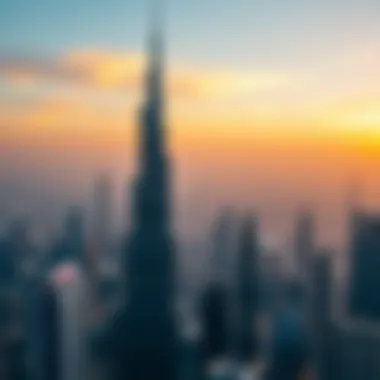

Symbol of National Pride
Burj Khalifa is more than just a physical structure; it is a colossal emblem of national pride for the United Arab Emirates. It draws attention to the country’s ambition and determination to position itself as a global player in various spheres—economic, cultural, and social.
For the people of Dubai, the tower represents their success in overcoming challenges and achieving greatness at an unprecedented scale. It also inspires younger generations to aim high, dreaming of their own monumental achievements. The symbolism of the building extends beyond national borders as it inspires nations worldwide to aspire for greatness, telling the story of what is possible when vision meets hard work.
In summary, the number of floors in the Burj Khalifa encapsulates deeper meanings relevant to culture, economy, urban development, and national identity. Each level serves as a statement of what the future holds, reminding us that reaching new heights often starts from the ground up.
The Experience of Burj Khalifa
Visiting the Burj Khalifa offers an unparalleled experience, intertwining luxury, art, and architecture seamlessly. It transcends being just a tall building; it’s a portal into the luxurious lifestyle and culture that Dubai embodies. From the moment you step foot in the area, there is an immediate sense of grandeur. The surrounding landscape, marked by the lavish Dubai Mall and the pristine fountain show, sets the stage for the drama that unfolds in the sky.
A trip to this skyscraper isn't merely about reaching dizzying heights. It's about experiencing the blend of modern engineering and cultural significance—a true hallmark of Dubai's vibrant spirit. Several elements contribute to this experience, making it one that potential investors, renters, and tourists may find distinctively compelling.
Visitor Access and Attractions
Getting to the Burj Khalifa is relatively simple, thanks to its location in Downtown Dubai—a hub of activity. The main entry is through the Dubai Mall, which has numerous attractions, including shops, luxury brands, and entertainment zones. Visitors usually recommend arriving early to avoid long lines—not just for the building itself but to truly soak in the atmosphere of the mall and its surroundings.
Visitors can buy tickets online or at kiosks nearby, offering a straightforward process to access the building. Here’s what you can expect:
- Time slots: Pre-booking helps secure your desired experience, especially during peak hours.
- Fast Track: There are options for fast track entry, which is a boon for those short on time.
- Guided Tours: Some might choose a guided tour for in-depth learning about the tower’s construction and history.
Upon entering, the artful blend of technology and hospitality welcomes you, leading up to various attractions in the vicinity, including art shows and cultural displays that highlight the Emirati heritage.
Observation Deck and Views
The crown jewel of the Burj Khalifa experience is undoubtedly its observation decks. "At the Top" on the 124th floor provides breathtaking views of the city, desert, and ocean, while the observation deck on the 148th floor offers even more exclusivity and a less crowded experience. Here, visitors can enjoy 360-degree panoramic views of Dubai—the expanse appears like a futuristic landscape, a mesmerizing mix of earth and sky.
From these heights:
- Dubai Fountain: Witness the magnificent fountain shows, where water dances to music in a mesmerizing display.
- Downtown Dubai: Gaze at the sprawling urban landscape, a testament to modern development and ambition.
- Desert and Coastline: On a clear day, you can catch a glimpse of the Arabian Gulf to the west and the tranquil deserts to the east.
The experience is enhanced by advanced telescopes available at the decks, allowing for a more intimate view of notable landmarks. A visit at sunset can paint the sky in a palette of oranges and purples, creating a memory that lingers long after descending back to earth.
Dining and Leisure Facilities
After taking in the views, the Burj Khalifa hosts various dining and leisure facilities that cater to diverse palates. The Atmosphere Restaurant on the 122nd floor rises above the ordinary with its chic ambiance and exquisite culinary offerings. It is not merely a meal, but an experience—diners can indulge in gourmet cuisine while enjoying unrivaled views of the city below.
Other leisurely spots include:
- Café: The Lounge on the 148th-floor for a more casual atmosphere, perfect for a coffee or a light snack.
- Souvenir Shops: Providing unique memorabilia that captures the essence of your visit.
- Sky-high Events: The venue can host private gatherings, exemplifying luxury in an unforgettable setting.
Dining in the Burj Khalifa is not just about food; it's about enjoying the entire experience of being in one of the tallest buildings in the world.
Burj Khalifa in Popular Culture
The Burj Khalifa, standing tall at 828 meters, is not just an architectural marvel, but also a significant cultural symbol recognized worldwide. Its prominence in popular culture has been established through cinema, television, and various forms of media, becoming an indispensable reference point for global audiences. This section unpacks how Burj Khalifa has influenced various facets of cultural expression, showcasing not only its physical grandeur but also its broader significance within society.
Representation in Media and Film
Burj Khalifa has made more than just a cameo in films; it has often played a pivotal role, symbolizing aspiration, modernity, and sometimes, even peril. One of its most notable appearances is in the action film "Mission: Impossible – Ghost Protocol," where Tom Cruise ends up scaling the tower's iconic glass facade. This scene showcased not only the daringness of the character but also emphasized the stunning height and sleek design of this skyscraper.
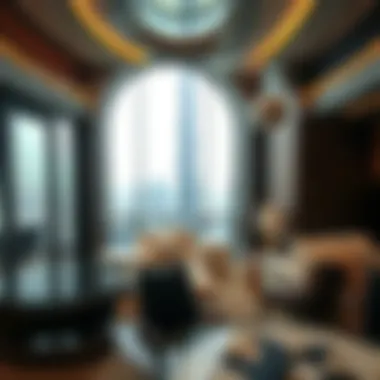

Moreover, the building has featured in various TV shows, documentaries, and even music videos, becoming a frequent backdrop for scenes requiring a breathtaking view. For instance, in the reality series "The Amazing Race," contestants have tackled challenges that involved navigating the areas surrounding Burj Khalifa, thus seamlessly integrating the structure into popular entertainment. Such portrayals contribute to the building’s status as a global icon, reinforcing Dubai's reputation as a modern metropolis.
This frequent representation in media solidifies Burj Khalifa’s place in contemporary culture, making it a landmark that audiences can recognize instantly. The tower often serves as a symbol of excellence, representing not just the architectural feat but also the aspirations of those who dream big.
"The Burj Khalifa is not just a structure; it’s a canvas for storytelling, capturing the dreams of the modern age."
Influence on Global Tourism
In addition to its appearances in media, Burj Khalifa stands as a beacon for global tourism. It draws millions of visitors each year, who come to experience its observation decks and panoramic views of Dubai. The unprecedented height creates an unparalleled perspective of the cityscape, often featured in travel brochures and online blogs as a must-see attraction. As tourists flock to witness this luxury, it has sparked an increase in tourism-related activities around the building.
The Burj Khalifa’s effect on tourism is multi-faceted:
- Helps drive economic growth: The influx of visitors necessitates a boost in local businesses, ranging from hotels to restaurants.
- Catalyst for cultural exchanges: Tourists from diverse backgrounds share their experiences, making the structure a melting pot of global culture.
- Enhancing Dubai's visibility: The tower represents a focal point that enhances the city's reputation on an international scale, affirming Dubai's place in the global tourism landscape.
Ultimately, Burj Khalifa transcends being a mere structure; it embodies the aspirations of many to reach new heights, both literally and metaphorically. Its constant presence in media, alongside its majestic role in tourism, cements its significance as a cultural cornerstone that reflects the innovations of modern urban design.
Environmental Sustainability Initiatives
Burj Khalifa is not just a marvel of modern architecture; it stands as a beacon of environmental sustainability in the world of skyscrapers. With the ever-growing concern regarding climate change and resource depletion, sustainable building practices have taken center stage. The Burj Khalifa's design and operations underscore the profound importance of ensuring that monumental structures contribute positively to the environment rather than detract from it. This section outlines key initiatives taken by Burj Khalifa that lead the way in energy use and resource conservation.
Energy Efficiency Measures
One of the standout aspects of Burj Khalifa is its commitment to energy efficiency. Implementing features that minimize energy consumption, this skyscraper employs a combination of innovative technologies and architectural designs. For instance, the building's façade is constructed with high-performance glass, which helps reduce the need for extensive cooling and heating. This glass is designed to reflect sunlight, keeping the interior cooler without relying heavily on electricity.
Among the array of strategies employed, smart building systems play a crucial role. These systems monitor energy usage in real-time, optimizing lighting and temperature conditions based on occupancy and time of day. Such a proactive approach not only saves energy but also enhances the overall comfort of the tenants and visitors. Furthermore, LED lighting is utilized throughout, cutting down electricity consumption significantly compared to traditional lighting methods.
An important note is that the Burj Khalifa was recognized by the Leadership in Energy and Environmental Design (LEED) for its commitment to energy sustainability. This stamp of approval highlights its responsible approach to energy use and serves as a model for future developments.
Water Conservation Strategies
Water conservation within Burj Khalifa speaks volumes about the building's dedication to sustainability. In a region where water can be a scarce resource, every drop counts. The tower incorporates several water-saving strategies which include a rainwater harvesting system. This system collects rainwater that may fall on the roof, channeling it to storage tanks for later use in irrigation and non-potable applications.
Moreover, the building is equipped with low-flow fixtures and appliances. These features work to reduce water usage significantly, ensuring that water wastage is kept to a minimum. The landscape surrounding Burj Khalifa has also been selected carefully, consisting of native and drought-resistant plants that require minimal irrigation. This selection not only preserves the precious water resources but also enhances the aesthetic appeal of the environment around the tower.
"Environmental sustainability is increasingly becoming a norm rather than an exception in modern architecture. Burj Khalifa stands tall as a testament to this trend."
Culmination
The conclusion wraps up the exploration of Burj Khalifa, a landmark that is not only a feat of engineering but also a symbol of aspiration and innovation. Understanding the final elements of the skyscraper's narrative is essential for discerning its broader impact within the realms of architecture and urban design.
Future of Skyscrapers in Urban Design
Looking ahead, the future of skyscrapers in urban design seems bright yet complex. As cities grow, the demand for vertical living and working spaces increases. Skyscrapers like Burj Khalifa showcase how such structures can blend functionality, aesthetics, and sustainability.
- Technological Advances: Modern technologies are making it possible to build even taller and more efficient buildings. Innovations in materials such as carbon fiber and modular construction techniques may redefine what’s possible in urban landscapes.
- Sustainability: Future skyscrapers are likely to focus more on green initiatives. These include energy-efficient systems, solar panels, and vertical gardens, which not only enhance the aesthetic appeal but also lessen the environmental footprint.
- Adaptive Reuse: More designers are considering new buildings as part of a historical context. Instead of demolishing old structures, integrating them into new designs may offer a more harmonious approach to urban growth.
As cities continue to evolve, the Burj Khalifa stands as a precedent for future projects, illustrating that the skyscrapers of tomorrow can be both functional and artistically significant.
Legacy of Burj Khalifa
The legacy of Burj Khalifa extends far beyond its height. This structure represents an ideological and cultural shift. In a way, it embodies the ambition that cities can aspire towards, indicating where society could be heading. Its influence can be seen in various facets:
- Cultural Significance: The Burj Khalifa has become an icon of Dubai, attracting millions of visitors and serving as a venue for global events and celebrations. It symbolizes the rapid development of the United Arab Emirates and the possibility of dreaming big.
- Economic Impact: The tower has contributed significantly to Dubai’s economy by boosting tourism, attracting business investments, and providing a model for future developments in the region. Real estate values within its vicinity have soared, showcasing the potential profitability of skyscraper-centric urban planning.
- Architectural Inspiration: Burj Khalifa’s design has inspired architects around the world. Its elegant lines and innovative use of space have opened the door for new ideas in architectural design, prompting a focus on integrating form with function.
In summary, the Burj Khalifa’s legacy is a blend of cultural pride, economic prosperity, and architectural inspiration. As it reaches into the sky, it challenges future generations to reach beyond what is currently conceivable.
"The Burj Khalifa is not just a structure, it’s a statement. It narrates a story of ambition and human potential."


